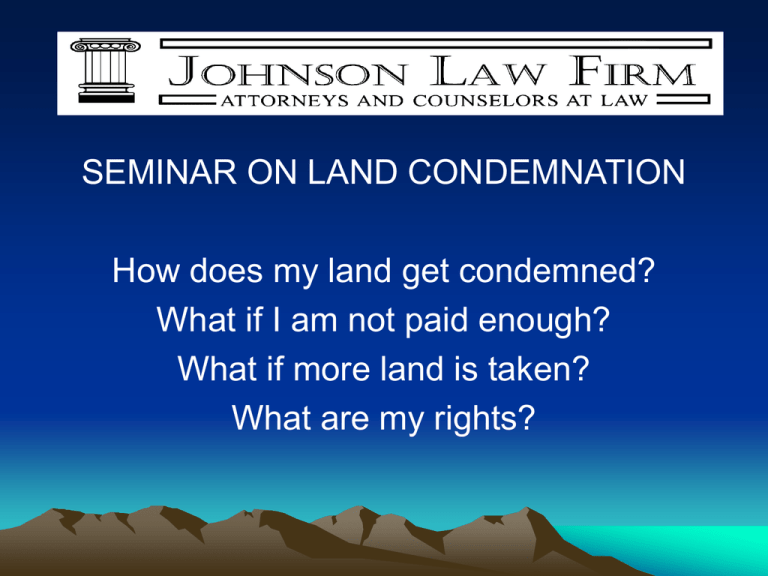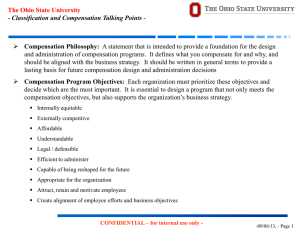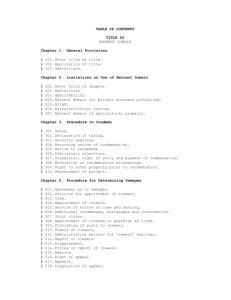D.O.T. vs. YOU - Johnson Law Firm
advertisement

D.O.T. vs. YOU SEMINAR ON LAND CONDEMNATION How does my land get condemned? What if I am not paid enough? What if more land is taken? What are my rights? D.O.T. vs. YOU INSTITUTION OF ACTION § 136-103 The D.O.T. shall file a complaint and declaration of taking It must include: 1. A statement of authority and public use for land 2. A description of tract or tracts taken 3. A statement of the estates or interests in the land 4. Names, addresses, competency, and unknowns 5. Sum of $$ “estimated” to be just compensation D.O.T. Must Deposit $$$ G.S. § 136-203. The filing of the complaint shall be accompanied by a deposit of money. Sub (d) “The D.O.T. may amend the complaint and declaration of taking and may increase the amount of its deposit with the Court at any time.” –Does not happen often. Get Life Estate Valued ASAP! G.S. §136-104. “Where there is a life estate and a remainder interest either vested or contingent, in lieu of the investment of the proceeds of the amount determined and awarded as just compensation to which the life tenant would be entitled to the use during the life estate, the court may in its discretion order the value of said life tenants share during the probable life of such tenant be ascertained as now provided by law and paid directly to the life tenant out of the final award as just compensation established by the judgment in the cause and the life tenant may have the relief provided for in G.S. § 136-105.” Value of Life Estate How do you value the life tenant’s share? - It is the present value of the expected life span. Judge will use actuary tables See G.S. § 44-11 for more details Applying for Disbursement • G.S. §136-105. Persons named in the complaint may apply to the judge for a disbursement, either as full compensation, or as a credit against just compensation. • Can not use if a dispute about title. • D.O.T. does not need notice, but you must serve the Judge’s Order on D.O.T. D.O.T.’s Answer & Plat The Answer shall contain (G.S. §136-106) 1. Admissions or denials 2. Names and addresses of Defendants 3. Affirmative defenses and other matters Note Also: Answer is deemed denied. You can force a map to be filed 6 months after complaint is filed. Time Rules How long to you have to file an answer? - 12 months (Normally 1 month) - Failure to file is an admission you received just compensation! - Judge may extend time by one month (13 months is the absolute max) Section 404: Clean Water Act Presented by Gary A. Mitchell • What are considered waters of the United States? • Intercoastal Waterway – Obviously Yes • Rivers - Yes • Streams (Wet or Dry) - Maybe • Bays - Maybe • Low Areas - Maybe Land can become Wet Lands! • Existing vs. Caused by Man (Example: Improperly installed funnel drain) • Soil can become wetter – use borings test • Plant matter changes over time • Dry areas reclaimed by wet areas • Could be delineated Wet Lands- regulated by the U.S. Army Corps. of Engineers. DOT Environmental Assessments • First, DOT requests landowner’s permission to enter landowner’s land • Second, Enter by Court Order if necessary. (Landowner could delay but not stop See §136- ) • DOT hired experts submit their reports and maps to U.S. Army Corps. of Engineers • Landowner should immediately get his/her own wet lands delineation. Points of Discussion Presenter Gary A. Mitchell • U.S. Army Corps. procedures to D.O.T. • U.S. Army Corps. procedures to Landowner • U.S. Army Corps. Appeals procedure • Referral to Environmental Protection Agency (E.P.A.) Fight About Area Taken First! G.S.§108 Is For Issues Other Than Damages After the filing of the plat, the judge, upon motion and 10 days notice by either the D.O.T. or the owner, shall, either in or out of term, hear and determine any and all issues raised by the pleadings other than damages, including, but not limited to, if controverted, questions of necessary and proper parties, title to land, interest taken, and area taken. Don’t Make This Mistake! D.O.T. vs. Tilley, 136 N.C. App. 370 (2000) “ A condemnation hearing should proceed to trial only after all issues other than that of just compensation have been resolved – a controversy as to what land a condemnor is seeking to condemn has no place in a condemnation proceeding.” G.S. § 136-108 D.O.T. vs. Tilley, 136 N.C. App. 370 (2000) “Here defendants failed to avail themselves of the mechanism provided in section 108, and instead Specifically stipulated that only the matter of just Compensation remained for resolution at trial. We will not reward this failure on appeal.” • Bad words for a lawyer. Call your malpractice carrier. G.S. § 136-108 • Remember if you loose a 108 hearing you must immediately appeal or you loose the right. • Smith vs. City of Charolotte, 339 S.E.2d 844, 847 (1986). “Orders from a condemnation hearing concerning title and area taken are ‘vital preliminary issues’ that must be immediately appealed.” Take Action! • Answer: Get your evidence together, get your experts ready with their reports, and file for a 108 hearing. • Experts: Surveyor, Appraiser, Wetland Delineator & Clean Water Expert, Forensic Accountant, Realtor® What is Inverse Condemnation? • Smith vs. City of Charlotte, 339 S.E.2nd 884 (1986). “Inverse condemnation is simply a device to force a government body to exercise its power of condemnation, even though it may have no desire to do so” • For Counties, Cities, Towns, Authorities etc. use G.S. §40A-51 §111 Inverse Condemnation YOUR BURDEN OF PROOF: 1. 2. 3. 4. 5. Condemnor failed to pay compensation or file condemnation proceedings Condemnor’s actions amount to a “taking”. The taking involved acquisition of property or rights for which it is obligated to pay compensation. Property is owned or possessed by one who has rights. Examples: Life estate, 50 year lease Condemnor took property for a public purpose. §111 Inverse Condemnation D.O.T.’s DEFENSES: 1. 2. 3. 4. 5. 6. 7. Didn’t do it. Defendant lawfully acquired the use of it. Example: Assignment of 50 year lease. Application of Res Judicata (A prior case) Acquiescence without compensation (Who would do this?) Claim barred by Statute of Limitations (S.O.L.) Adverse possession or prescriptive easement Did it. - But you don’t have the right to the money $$$. Some Examples: Nuances: Which are Inverse takings? • Runway and low flying aircraft? NO! • Landfill full of toxic chemicals? NO! • Stinking odors from a trash dump? YES! More Examples: • Severing a cable under a radio station? NO! • Stinking odors from a sewage plant? YES! §111 Inverse Condemnation MY CONCLUSION: Judges sitting on appellate courts have extremely sensitive noses!!! How to Measure Damages G.S. §136-112 The following is the measure of damages to be determined by the commissioners, jury, or judge who determines the issue of damages: (1) Where only a part of a tract is taken, the measure of damages for said taking shall be the difference between the fair market value of the entire tract immediately prior to said taking and the fair market value of the remainder immediately after said taking, with consideration being given to any special or general benefits resulting from the utilization of the part taken for highway purposes. Measure of Damages: Entire Tract (2) Where the entire tract is taken the measure of damages for said taking shall be the fair market value of the property at the time of the taking. Special & General Benefits What are they and why do they matter? D.O.T. vs. Rowe, 353 N.C. 671 (2001) • D.O.T. condemned 11.41 acres of a 18.42 acre tract to complete an interchange to I-40 in Catawba County. The jury returned a verdict of $0.00. • The verdict reflected the fact that the jury agreed with the D.O.T. that general benefits to the remaining property exceeded the cost in loss of acreage. General Benefits D.O.T. vs. Rowe, 353 N.C. 671 (2001) “Increases in the value of land which arise from the fulfillment of the public project which justified the taking and which result from the enjoyment of the facilities provided by the new public and from the increased general prosperity resulting from such enjoyment” General Benefits Examples include: • Rise in value due to increase traffic flow (would apply to business area). • Rise in value due to aesthetic upgrade of the neighborhood. • Creation of more convenient parking. Special Benefits D.O.T. vs. Rowe, 353 N.C. 671 (2001) “Increases in the value of land which arise from the peculiar relation of the land in question to the public improvement.” Special Benefits Examples include: • New road frontage • New beach or pier access • New frontage to man made lake What happened to Mr. Rowe? The Supreme Court said: “The legislature has decided that the state can reduce damages by all of the benefits accruing and that decision rests with the legislature in conferring the right of eminent domain. If defendants are dissatisfied with the result, then their recourse is with the legislature.” Result: Supreme Court reversed Court of Appeals. Mr. Rowe got $0. Interest G.S. § 136-113 • Interest is allowed at the legal rate from the date of taking to the date of judgment. • Interest is not allowed on what D.O.T. paid into Court. Get Costs Back in Inverse Claims G.S. §136-119 Costs and Appeal: Look at Third Paragraph: “The judge rendering a judgment for the plaintiff in a proceeding brought under G.S. § 111 [Inverse Condemnation] awarding compensation for the taking of property, shall determine and award or allow to such plaintiff, as a part of such judgment, such sum as will in the opinion of the judge reimburse such plaintiff for his reasonable cost, disbursements and expenses, including reasonable attorney, appraisal, and engineering fees, actually incurred because of such proceedings.” Reimbursement for Property Taxes G.S. § 136-121.1 • A property owner who property is taken in Fee Simple (fee simple means the entire interest) is entitled to pro rata payment of his property taxes. • Pro Rata kicks in when title is vested in condemnor or when possession is taken, whichever is earlier. • Rules out easements, no matter how long it was used. Reimbursement for Property Taxes G.S. § 136-121.1 And If: You are a person who paid deferred taxes and you own agricultural, horticultural, or forestland that was in production, and is contiguous to the condemned land, then you get all your deferred taxes paid. Reimbursement for Taxes Attention Farmers: Machinery Act §105-277.4(c) says: “The difference between the taxes due on the presentvalue basis and the taxes that would be payable in the absence of this classification, together with any interest, penalties, or costs, must be carried forward in the records of the taxing unit or units as deferred taxes. The taxes become due and payable when the land fails to meet any condition or requirement for classification.” Valuation Issue: Unified tracts City of Winston Salem vs. Slate, 185 N.C. App. 33 (2007). The City condemned land to put in a permanent sewer easement. There was a 75 acre tract and a smaller one. The City wants the parcels valued separately. Some of the landowners want tracts valued as one unified tract. The trial judge would not let in evidence that several tracts could be valued as a unified tract. LANDOWNER’S DESIRE = value as unified tract CONDEMNOR’S DESIRE = value as separate tracts Valuation Issue: Unified tracts City of Winston Salem vs. Slate, 185 N.C. App. 33 (2007). Factors to Determine a Unified Tract: 1. Physical unity. 2. Unity of ownership. 3. Unity of use. Court said: “Although all three factors need not be present, some unity of ownership must be established when separate parcels of land are involved.” Valuation Issue: Unified tracts City of Winston Salem vs. Slate, 185 N.C. App. 33 (2007). Ruling from the Court: “Based upon the possibility that defendants may be able to show a unity of ownership as to some of the additional tracts, we cannot say the trial court’s error was harmless.” REVERSED. Valuation Issue: Physical Unity Question: Do streets and roads break up physical unity? D.O.T. vs. Roymac Partnership, 158 N.C. App. 403 (2003). • D.O.T. argues the existence of Roymac Drive breaks up the physical unity of the parcel from the condemned lots, and therefore, there is no physical unity to the tract. • General Rule: Lands separated by an existing street which is open to the public are independent parcels. Valuation Issue: Physical Unity D.O.T. vs. Roymac Partnership, 158 N.C. App. 403 (2003). Exception to the General Rule: “If a tract of land, no part of which is taken, is used in connection with the same farm, or the same manufacturing establishment, or the same enterprise of any other character as the tract, part of which was taken, it is not considered a separate and independent parcel merely because it was bought at a different time, and separated by an imaginary line, or even if two tracts are separated by a highway, railroad, or canal. Valuation Issue: Direct Access D.O.T. vs. Harkley, 308 N.C. 148 (1983). “A landowner is only entitled to damages for a deprivation of direct access to a highway where, before the condemnation occurred, his property abutted the highway to which he is denied direct access.” Valuation Issue: Future Uses City of Charlotte vs. Hurlahe Jr., 178 N.C. App. 144 (2006). City of Charlotte condemns parking spaces in an airport. City deposits $842,500.00. Jury returns verdict of $2,000,000.00. Owners testify they intended to use the property as a valet parking business. Court admitted evidence concerning net income of a hypothetical parking business. Valuation Issue: Future Uses City of Charlotte vs. Hurlahe Jr., 178 N.C. App. 144 (2006). Can you get intended future use into evidence? “… if an owner has taken steps prior to the date of the taking to adapt his land for future uses, the future uses to which the land is adapted are admissible”. Important: If you land is being taken, take steps to convert it to the highest and best use!!! Valuation Issue: Zoning D.O.T. vs. Mahaffey, 137 N.C. App. 511 (2000). “When property is unavailable for a particular use because of a zoning ordinance, the possibility the property may be rezoned may be taken into consideration if there is a reasonable probability of a change in the near future. If the possibility that the property may be re-zoned is ‘purely speculative’, however, such possibility should not be considered.” Valuation Issue: Great Offers Can you testify about that great offer? Highway Commission vs. Helderman, 285 N.C. 654, (1974) “A mere offer to buy or sell property is incompetent to prove its market value. The figure named is only the opinion of one who is not bound by his statement and it is too unreliable to be accepted as a correct test of value.” Valuation Issue: Owner’s opinion D.O.T. vs. M.M. Fowler, 361 N.C. 1 (2006). “Further, a landowner may express an opinion as to the fair market value of the property for the jury to weigh because it is generally understood that the opinion of the owner is so far affected by bias that it amounts to little more than a definite statement of the maximum figure of his contention.” Practice: Landowner’s opinion is as important as “experts”. I.R.C. § 1033 • Can be utilized when condemnation or threat or imminence of condemnation • Defers taxable gain on proceeds from condemnation • Taxpayer must make a timely election and timely replacement of proper • Omitting gain on a gain year tax return is a “Deemed” election I.R.C. § 1033 • You do not need an intermediary (Like in a 1031 exchange) • “Proceeds” of condemned real property held for productive use in trade or business or for investment may be rolled into “Like Kind” property • Three year replacement period instead of two years I.R.C. § 1033 -ExampleA fire destroys Columbus Railroad Depo on July 15th 2010. The insurance recovery the Depo receives results in a gain. The Depo reports the gain on its calendar year 2010 return. If the Depo later decides to seek deferral of all or part of the gain, it must make the delayed election by December 31st 2012. (2 years from the gain year - 1033(a)(2)(B)) The Depo must acquire qualifying replacement property (commercial use) by December 31st 2013 and report the details on its 2013 tax return due March 15th 2014. I.R.C. § 1033 -Last Pointers- • Replacement period for residential houses is 2 years • It is possible to get extension of time for replacement period but not election period • You must designate property on the tax return to complete the election, merely acquiring otherwise qualifying replacement property is not sufficient. WE HOPE YOU LEARNED A LOT! THANK YOU FOR ATTENDING OUR SEMINAR! ATTORNEY WILL JOHNSON TOLL FREE (866) 881-2252 www.johnsonlawyers.net






